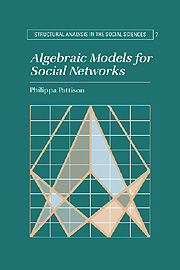Book contents
- Frontmatter
- Contents
- List of figures and tables
- Preface
- 1 Algebraic representations for complete social networks
- 2 Algebraic representations for local social networks
- 3 Comparing algebraic representations
- 4 Decompositions of network algebras
- 5 An analysis for complete and local networks
- 6 Time-dependent social networks
- 7 Algebras for valued networks
- 8 Issues in network analysis
- References
- Appendix A Some basic mathematical terms
- Appendix B Proofs of theorems
- Author index
- Subject index
1 - Algebraic representations for complete social networks
Published online by Cambridge University Press: 21 October 2009
- Frontmatter
- Contents
- List of figures and tables
- Preface
- 1 Algebraic representations for complete social networks
- 2 Algebraic representations for local social networks
- 3 Comparing algebraic representations
- 4 Decompositions of network algebras
- 5 An analysis for complete and local networks
- 6 Time-dependent social networks
- 7 Algebras for valued networks
- 8 Issues in network analysis
- References
- Appendix A Some basic mathematical terms
- Appendix B Proofs of theorems
- Author index
- Subject index
Summary
Social networks are collections of social or interpersonal relationships linking individuals in a social grouping. The study of social networks has been gaining momentum in the social sciences ever since studies conducted in the 1950s by Barnes (1954), Bott (1957) and others demonstrated the important role of social networks in understanding a number of social phenomena. Social networks have since come to span a diverse theoretical and empirical literature within the social sciences. They have been invoked in a variety of roles in different theoretical contexts and have been conceptualised in a number of ways. The frequency of use of the notion of social network is probably not surprising because an individual's behaviour takes place in the context of an often highly salient network of social relationships. Perhaps more striking is the range of theoretical roles that have been proposed for the social network concept. Social networks have been used to explain various characteristics and behaviours of individuals; they have also been used to account for social processes occurring in both small and large groups of individuals. In addition, they have been viewed as dependent on individual attributes and behaviours, as well as consequences of such aggregate social attributes as the level of urbanisation of a community.
For example, in one type of network research, social scientists have examined the nature of social networks as a function of structural variables such as occupation, stage in life, gender, urbanisation and industrialisation (Blau, 1977; Coates, 1987; Feiring & Coates, 1987; Fischer, 1982; Fischer, Jackson, Stueve, Gerson & McAllister Jones, 1977; Wellman, 1979).
- Type
- Chapter
- Information
- Algebraic Models for Social Networks , pp. 1 - 55Publisher: Cambridge University PressPrint publication year: 1993



